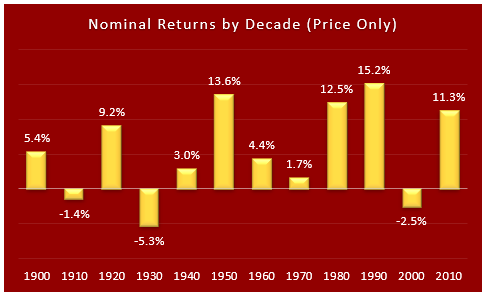B.S. articles about investing are everywhere.
They appear, unsolicited, in your mailbox, your inbox, your Facebook feed, your Twitter feed, and even in the mainstream financial media outlets like CNBC, Bloomberg, Barron's, Marketwatch and many others.
How good are you at detecting B.S. when you read an article or blog post about investing? This series of articles is intended to fine-tune your natural B.S. Detector so that you will at least have a fighting chance to avoid the tricks, traps, and snow-jobs that permeate the financial media landscape.
In this installment I'll unpack the B.S. in an article that has gotten a ton of media attention due to its sponsorship by a well-respected thought leader.
Here's the headline from Marketwatch.
Stocks are up 495% in the past decade - here’s why you probably aren’t.
How's that for a click-bait headline? Not bad, right?. But the article, and the one it links to, are loaded with flaws. And the entire premise is sketchy at best, and misleading at worst. (You can read the article here.)
The headline of the article -that stocks are up 495% in the past decade - is B.S. Stocks (using the S&P 500 as a proxy) are up 284%, not 495% as the headline claims. Here's the arithmetic:
S&P 500 on January 8, 2010 - 1144.98
S&P 500 on January 8, 2020 - 3253.05
Gain for the past decade is (3253.05 / 1144.98) or 284%.
This works out to a compound annual growth rate (CAGR) of 11% for the past decade. Very good, indeed.
The chart below shows the CAGRs for each decade from 1900 to the present. So why embellish it? I think it's because the author is trying to make a point (aren't we all?).
The point of the article
I have no argument with what I see as the point of the article. It was a great decade for stock investors. But again I ask, why embellish the numbers? It's a common practice, and it's very easy to pull off. To make a point in an article, all one needs to do is shift the start and end dates of their calculation and voila! Point made.
It's important that I add that I'm not accusing Marketwatch, or the author of the original article, of having a nefarious intention here. I'm just pointing out that it's very easy to make the numbers support your point of view, whatever that happens to be.
Lessons Learned
What I learned from this Marketwatch article, and the original article, is that the decade just past was among the best for investors who de-emphasized the scary headlines and stayed invested. That's a very valuable lesson for all of us.
But it doesn't mean that the next decade will be so kind and generous for stock investors. I suspect that the CAGR for the coming decade will be significantly lower than 11%. But that's just my opinion.
Preview of coming installments of this series
I've already covered the myth of Buy & Hold as the best strategy for everyone, at all times. And I covered the myth of stock-picking as the surest way to make a killing in the market.
In upcoming installments I'll debunk the Elliott Wave Theory and other purely technical investment strategies. I'll also tackle so-called "Evidence-Based" investment strategies and expose them for what they really are - a way for investment advisers and fund managers to capture your money and turn it into an annuity with them as the primary beneficiary.

